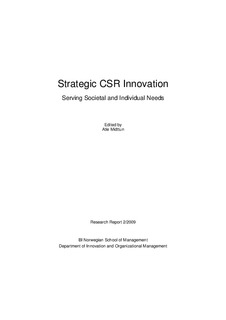Strategic CSR Innovation - Serving Societal and Individual Needs
Research report
Permanent lenke
http://hdl.handle.net/11250/94093Utgivelsesdato
2009Metadata
Vis full innførselSamlinger
- Research Reports [141]
Sammendrag
This report explores the challenges and opportunities of strategic CSR, and is primarily based on three cases of CSR-driven innovation in Norway. The study has been undertaken within the framework of a project on CSR-driven innovation organised and partially financed by the Nordic Innovation Centre and carried out by the business schools in the four Nordic capitals. Copenhagen Business School; BI – Norwegian School of Management, Helsinki School of Economics, Reykjavik Business University, Stockholm School of Economics.
Some of the central insights emerging from this explorative study are that CSR-driven innovation entails a number of specific possibilities and constraints:
1) It allows a move beyond defensive and proactive CSR into a more rewarding synthesis between social and commercial concerns.
2) It introduces the paradigm of serving both societal and individual needs, thereby transcending the division between public and private goods.
3) It necessitates an alignment between micro-level business strategy and macro-level societal needs.
4) It creates new opportunities for finance, organisation, marketing and regulation, and allows new dynamic alignments to drive learning investments, niche markets and product differentiation.
Chapter 1 discusses the core possibilities and constraints of CR-driven innovation, based on the three Norwegian cases that are presented in the following chapters 2 to 4. Chapter 5 provides some brief concluding remarks.
Serie
Research Report2/2009
